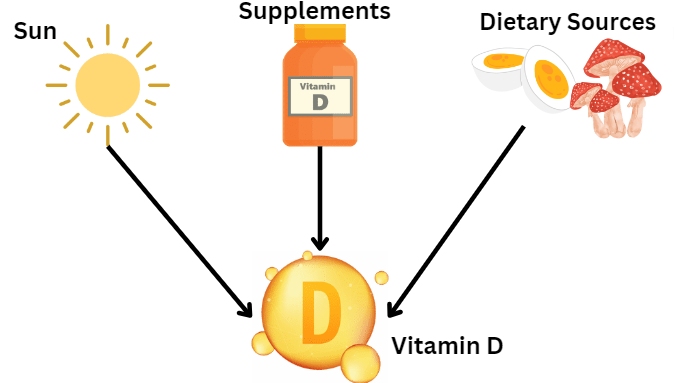Vitamin D Deficiency Disease: Humans of the modern generation have kept the concern of their health at the backseat and living their lives that include adulteration and a vitamin-deficient lifestyle. As per the National Library of Medicine, vitamin D deficiency is the most common nutritional deficiency found in people of all ages.
For students and kids, vitamin D is essential for maintaining strong bones, a robust immune system, and even mental health. In this article, we'll explore the importance of vitamin D for students and children and shed light on the risks associated with vitamin D deficiency.
Read: Skin Care Routine for Students
Table of Content
- What is Vitamin D?
- The Role of Vitamin D in Children
- Sources of Vitamin D
- Factors Affecting Vitamin D Absorption
- Recommended Daily Intake
- Vitamin D Deficiency in Children
- Signs and Symptoms of Vitamin D Deficiency
- Health Consequences of Vitamin D Deficiency
- Treating Vitamin D Deficiency
- Expert Speak
- Conclusion
What is Vitamin D?
Vitamin D (also referred to as “calciferol”) is a fat-soluble vitamin that the body can produce when exposed to sunlight. It's a unique nutrient because it can be synthesised naturally, and it doesn't necessarily have to come from the foods we eat. There are two primary forms of vitamin D: D2 (ergocalciferol) and D3 (cholecalciferol), with D3 being the most potent form.
.jpg)
Image caption: Vitamin D activation
Source: sciencedirect.com
The Role of Vitamin D in Children
Bone Health
Students or children are in the early phase of development, which requires proper nutrition for complete development. The bones of kids get strong during their physical development by absorbing enough calcium. One of the most well-known functions of vitamin D is its role in calcium absorption. A balanced amount of vitamin D ensures effective absorption and the development of bones and teeth.
Immune System Support
Our environment is full of bacteria and germs that can enter the living body at any time. The body requires a strong immune system to fight against such dangerous entries. Vitamin D has immune-modulating properties, meaning it helps the body fight off infections and reduce inflammation. Thus, students should have enough vitamin D to support their immune systems.
Mental Health
Mental health is a growing concern among students. Emerging research suggests a potential link between vitamin D deficiency and mood disorders like depression. This is a claim proven to some extent.
Source: NIH
Sources of Vitamin D
Like other nutritional elements, vitamin D can also be obtained from various sources. The main vitamin D sources are:
Sunlight
Vitamin D precursors are naturally present in a few foods, for example, cod liver oil, salmon, swordfish, tuna fish, etc. When ultraviolet (UV) rays from the sun hit our skin surface, they trigger the synthesis of vitamin D under the skin. Thus, it can be considered one of the sources of vitamin D.
Dietary Sources
While Vitamin D is not abundant in many foods, there are dietary sources that students can incorporate into their meals:
- Fatty fish (salmon, mackerel, and tuna)
- Fortified foods (milk, orange juice, cereals)
- Eggs
- Mushrooms (specifically, UV-exposed mushrooms)

Read: Vitamin D Supplementation for Infants, WHO
Supplements
Students and children who have limited access to sunlight and dietary sources can maintain the normal dose in the body by taking vitamin D supplements. However, taking a healthcare professional’s opinion before using vitamin D supplements is essential.
Factors Affecting Vitamin D Absorption
There are several factors that influence the body’s ability to absorb and utilise vitamin D:
Skin Colour
People with darker skin may require more sun exposure to produce the same amount of vitamin D as those with lighter skin.
Geographic Location
Those living at higher latitudes may struggle to get enough sunlight, especially during the winter months.
Age
As we age, our skin becomes less efficient at producing vitamin D, making supplementation more important for older adults.
Recognising Vitamin D Deficiency in Children
Vitamin D deficiency can manifest in various ways. Students, parents, and teachers should be aware of the signs and symptoms, including:
- Fatigue
- Bone and muscle pain
- Frequent illnesses
- Changes in mood, including depression
- Difficulty concentrating
Recommended Daily Intake
Check the age-wise Recommended Dietary Allowances (RDAs) for Vitamin D in the table below;
| Age | Male | Female | Pregnancy | Lactation |
| 0-12 months* | 10 mcg (400 IU) | 10 mcg (400 IU) | ||
| 1–13 years | 15 mcg (600 IU) | 15 mcg (600 IU) | ||
| 14–18 years | 15 mcg (600 IU) | 15 mcg (600 IU) | 15 mcg (600 IU) | 15 mcg (600 IU) |
| 19–50 years | 15 mcg (600 IU) | 15 mcg (600 IU) | 15 mcg (600 IU) | 15 mcg (600 IU) |
| 51–70 years | 15 mcg (600 IU) | 15 mcg (600 IU) | ||
| >70 years | 20 mcg (800 IU) | 20 mcg (800 IU) |
*Adequate Intake (AI)
Source: National Institutes of Health
Vitamin D Deficiency in Children
As per nature.com “Various studies in different parts of India have reported widespread prevalence of vitamin D deficiency in all age groups. It is estimated that the prevalence of deficiency is 62–95.7% in new-borns and breast-feeding groups (0–6 months), 46–80% in 6–60 months of age and 37.8–97.5% in 5–20-year-old children.”
Source: Vitamin D status and determinants in Indian children
Signs and Symptoms of Vitamin D Deficiency
Recognising the signs of vitamin D deficiency is crucial for maintaining your health. Common symptoms include:
- Fatigue: feeling constantly tired or lacking energy.
- Bone pain: aching bones and muscles, which can lead to conditions like osteoporosis.
- Frequent infections: an impaired immune system that results in more frequent illnesses
There are symptoms as well, which are the general signs of vitamin D deficiency. Having these signs does not mean you have a vitamin D deficiency. We suggest visiting a healthcare professional to confirm the same.
Health Consequences of Vitamin D Deficiency
If left untreated, vitamin D deficiency can have serious consequences.
- Increased risk of osteoporosis
- Cardiovascular issues
- Mental health challenges
- Rickets
- Compromised immune system
There could be other health consequences as well. We suggest visiting a healthcare professional to know and confirm the same.
Treating Vitamin D Deficiency
Treatment typically involves supplementation with vitamin D supplements, but your healthcare provider will determine the appropriate dosage.
Read: Skin Care Routine for Students
Expert Speak:“Vitamin D is a crucial nutrient that plays a vital role in the growth and development of children. It is responsible for maintaining healthy bones and teeth, supporting the immune system, and even influencing mood. However, vitamin D deficiency in children has become a concerning issue in recent years. Limited outdoor activities, use of sunscreen, and staying indoors for extended periods can reduce the body's ability to synthesize vitamin D from sunlight. A lack of vitamin D-rich foods in a child's diet, such as fatty fish, fortified dairy products, and egg yolks, can contribute to deficiency. Breast milk is naturally low in vitamin D. Infants who are exclusively breastfed may be at a higher risk of deficiency if not supplemented with vitamin D drops. Recognizing the signs of vitamin D deficiency in children is crucial for early intervention. Common symptoms may include: 1. Bone Pain: Children may experience pain and tenderness in their bones, commonly known as "growing pains." 2. Delayed Growth: Slower growth or shorter stature than expected for their age. 3. Frequent Infections: Weakened immune function leading to recurrent infections. 4. Muscle Weakness: Difficulty in activities that require muscle strength. Prevention Strategies include; 1. Sunlight: Encourage outdoor playtime, but be cautious about excessive sun exposure. Aim for 10-30 minutes of sun exposure to the face, arms, and legs a few times a week, depending on the child's skin type and location. 2. Dietary Sources: Incorporate vitamin D-rich foods into your child's diet. Include items like fatty fish, fortified dairy products, and fortified cereals. 3. Supplements: If recommended by a healthcare provider, provide your child with vitamin D supplements. The dosage will depend on your child's age and the severity of the deficiency. Vitamin D deficiency in children is a preventable and manageable condition. By understanding its causes, recognizing symptoms, and taking proactive steps to ensure adequate vitamin D intake, parents can promote the healthy development and well-being of their children. Always consult with a Doctor and Dietitian for personalized guidance on addressing vitamin D deficiency in your child.” |
| About the Expert: Ms. Manveer Kaur has more than 20 years of experience in nutrition and lifestyle advising. She is committed to providing her clients with the information and resources they need to make wise and lasting decisions since she feels that nutrition is the foundation of a healthy life. |
Conclusion
Vitamin D is an essential nutrient, and its deficiency can hamper the normal functioning of the body. Vitamin D deficiency is common in children and people of other ages. To prevent this, parents, teachers, and students should be aware of vitamin D symptoms and causes. They should be taught about various vitamin D deficiency diseases. Having proper education about vitamin D can prevent its deficiency in children.
Also read:
References

Comments
All Comments (0)
Join the conversation